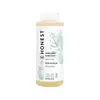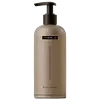What's inside
What's inside
 Key Ingredients
Key Ingredients

 Benefits
Benefits

 Concerns
Concerns

 Ingredients Side-by-side
Ingredients Side-by-side

Water
Skin ConditioningLauryl Glucoside
CleansingCocamidopropyl Hydroxysultaine
CleansingAloe Barbadensis Leaf Juice
Skin ConditioningGlycerin
HumectantDisodium Cocoyl Glutamate
CleansingSodium Chloride
MaskingDecyl Glucoside
CleansingSodium Cocoyl Isethionate
CleansingChamomilla Recutita Flower Extract
MaskingCalendula Officinalis Flower Extract
MaskingCocos Nucifera Fruit Extract
EmollientHeptyl Glucoside
Caprylyl Glycol
EmollientSodium Polyitaconate
Panthenol
Skin Conditioning1,2-Hexanediol
Skin ConditioningHydroxyacetophenone
AntioxidantTrisodium Ethylenediamine Disuccinate
Glutamic Acid
HumectantCoconut Acid
CleansingCitric Acid
BufferingWater, Lauryl Glucoside, Cocamidopropyl Hydroxysultaine, Aloe Barbadensis Leaf Juice, Glycerin, Disodium Cocoyl Glutamate, Sodium Chloride, Decyl Glucoside, Sodium Cocoyl Isethionate, Chamomilla Recutita Flower Extract, Calendula Officinalis Flower Extract, Cocos Nucifera Fruit Extract, Heptyl Glucoside, Caprylyl Glycol, Sodium Polyitaconate, Panthenol, 1,2-Hexanediol, Hydroxyacetophenone, Trisodium Ethylenediamine Disuccinate, Glutamic Acid, Coconut Acid, Citric Acid
Water
Skin ConditioningCocamidopropyl Hydroxysultaine
CleansingSodium Laurylglucosides Hydroxypropylsulfonate
CleansingDisodium Cocoyl Glutamate
CleansingSodium Cocoyl Isethionate
CleansingHeptyl Glucoside
Caprylyl Glycol
EmollientLavandula Angustifolia Flower Oil
MaskingChondrus Crispus Extract
Skin ConditioningCaprylhydroxamic Acid
Glycerin
HumectantPanthenol
Skin ConditioningAllantoin
Skin ConditioningFusanus Spicatus Wood Oil
MaskingPhytic Acid
Aloe Barbadensis Leaf Juice
Skin ConditioningSodium Hyaluronate
HumectantWater, Cocamidopropyl Hydroxysultaine, Sodium Laurylglucosides Hydroxypropylsulfonate, Disodium Cocoyl Glutamate, Sodium Cocoyl Isethionate, Heptyl Glucoside, Caprylyl Glycol, Lavandula Angustifolia Flower Oil, Chondrus Crispus Extract, Caprylhydroxamic Acid, Glycerin, Panthenol, Allantoin, Fusanus Spicatus Wood Oil, Phytic Acid, Aloe Barbadensis Leaf Juice, Sodium Hyaluronate
Ingredients Explained
These ingredients are found in both products.
Ingredients higher up in an ingredient list are typically present in a larger amount.
Aloe Barbadensis Leaf Juice comes from leaves of the aloe plant. Aloe Barbadensis Leaf Juice is best known for helping to soothe sunburns. It is also anti-inflammatory, moisturizing, antiseptic, and can help heal wounds.
Aloe is packed with good stuff including Vitamins A, C, and E. These vitamins are antioxidants, which help fight free-radicals and the damage they may cause. Free-radicals are molecules that may damage your skin cells, such as pollution.
Aloe Barbadensis Leaf Juice also contains sugars. These sugars come in the form of monosaccharides and polysaccharides, folic acid, and choline. These sugars are able to help bind moisture to skin.
It also contains minerals such as calcium, 12 anthraquinones, fatty acids, amino acids, and Vitamin B12.
Learn more about Aloe Barbadensis Leaf JuiceCaprylyl Glycol is a humectant and emollient, meaning it attracts and preserves moisture.
It is a common ingredient in many products, especially those designed to hydrate skin. The primary benefits are retaining moisture, skin softening, and promoting a healthy skin barrier.
Though Caprylyl Glycol is an alcohol derived from fatty acids, it is not the kind that can dry out skin.
This ingredient is also used as a preservative to extend the life of products. It has slight antimicrobial properties.
Learn more about Caprylyl GlycolCocamidopropyl Hydroxysultaine is a synthetic cleansing agent, though it is derived from coconut oil.
It is used to enhance the texture of products by boosting lather and thickening the texture. As a cleanser, Cocamidopropyl Hydroxysultaine is mild.
We don't have a description for Disodium Cocoyl Glutamate yet.
Glycerin is already naturally found in your skin. It helps moisturize and protect your skin.
A study from 2016 found glycerin to be more effective as a humectant than AHAs and hyaluronic acid.
As a humectant, it helps the skin stay hydrated by pulling moisture to your skin. The low molecular weight of glycerin allows it to pull moisture into the deeper layers of your skin.
Hydrated skin improves your skin barrier; Your skin barrier helps protect against irritants and bacteria.
Glycerin has also been found to have antimicrobial and antiviral properties. Due to these properties, glycerin is often used in wound and burn treatments.
In cosmetics, glycerin is usually derived from plants such as soybean or palm. However, it can also be sourced from animals, such as tallow or animal fat.
This ingredient is organic, colorless, odorless, and non-toxic.
Glycerin is the name for this ingredient in American English. British English uses Glycerol/Glycerine.
Learn more about GlycerinWe don't have a description for Heptyl Glucoside yet.
Panthenol is a common ingredient that helps hydrate and soothe the skin. It is found naturally in our skin and hair.
There are two forms of panthenol: D and L.
D-panthenol is also known as dexpanthenol. Most cosmetics use dexpanthenol or a mixture of D and L-panthenol.
Panthenol is famous due to its ability to go deeper into the skin's layers. Using this ingredient has numerous pros (and no cons):
Like hyaluronic acid, panthenol is a humectant. Humectants are able to bind and hold large amounts of water to keep skin hydrated.
This ingredient works well for wound healing. It works by increasing tissue in the wound and helps close open wounds.
Once oxidized, panthenol converts to pantothenic acid. Panthothenic acid is found in all living cells.
This ingredient is also referred to as pro-vitamin B5.
Learn more about PanthenolSodium cocoyl isethionate is a natural ingredient from coconut oil. It is an ultra gentle cleanser that gives a nice foam without drying the skin or impacting the skin barrier.
The amount of foam created depends on the amount of sodium cocoyl isethionate used in the product.
This ingredient also helps improve the spreadability of a product.
Learn more about Sodium Cocoyl IsethionateWater. It's the most common cosmetic ingredient of all. You'll usually see it at the top of ingredient lists, meaning that it makes up the largest part of the product.
So why is it so popular? Water most often acts as a solvent - this means that it helps dissolve other ingredients into the formulation.
You'll also recognize water as that liquid we all need to stay alive. If you see this, drink a glass of water. Stay hydrated!
Learn more about Water